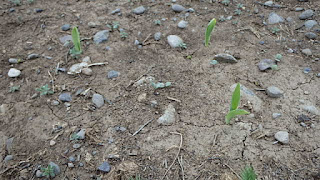The first stage of the build involved attaching the cattle panels to boards using fencing staples. Each of the long sides comes out to be about twelve and a half feet long and three cattle panels fit this length perfectly. Once a board was attached to each side of the panels, we then bent the panels over and secured each end with an eight foot long board. My friend then strengthened the corners by screwing diagonal supports in the base frame. While he did this, I did my best to wire the panels tightly together to minimize their shifting and movement on the frame.
Once everything seemed to be in place, we added crossbeam supports at the back of the enclosure to help stabilize it and to give us a framework to attach the chicken wire to. We then laid the tarps over the top and secured them to the frame with wire. I am not going to enclose the whole structure in plastic at this point because the meat chickens won't need the extra protection from the elements since they will only be in here for a few months during the warmest season of the year. I just want to make sure that they have good ventilation and a shady place to hang out on sunny, hot afternoons.
The next step was attaching the frame for the door and mounting the door in that frame. It was just a simple matter of screwing boards to the bottom frame and then securing them in place at the top of the arch in the cattle panel. We added a tie beam across the middle of the pen to keep the two long sides from bowing out in middle. In the back half of the pen we added a couple pieces of a left over board to provide roosting spaces for the birds. I may have to add a few more for them as they get bigger, but for now I think that two roosts is a good start.
The last big part of this project is installing the chicken wire around the bottom half of the enclosure to keep the baby chicks contained, and to keep predators out. I will also use chicken wire fencing to close off the tops of the arches in the back of the enclosure and on either side of the door. When the young meat chickens first move outside, I will probably have to come up with a temporary brooder area to give them a little protection from the wind and also to give them a place to warm up if they need it. Hopefully, they will feather out well enough in a few short weeks to make the move to the great outdoors.
The final step will be to install the stroller wheels to the front of the tractor and also some kind of handle to the back so I can simply tilt the tractor up a little on to its wheels and move it around the yard. I think this tractor is a perfect size to house my small flock of meat chickens. It also happens to be a good size to fit over my garden beds once it is done being used to raise meat chickens for the summer. For the fall it will probably become my season extending greenhouse and all I need to do is cover it completely with clear plastic to make this happen. I may also use it for my egg chickens in the winter to give them a larger protected area to hang out in during the cold, dark months of the year. They would probably do a good job cleaning up my garden beds for the next season while they add a good measure of fertilizer.
































